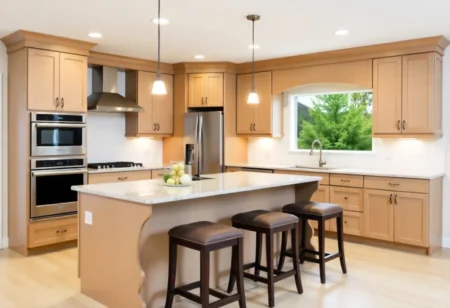The kitchen serves as the heart of modern homes, yet many struggle with limited counter space and storage constraints. Latitude Run’s rolling kitchen island offers additional storage and workspace for your kitchen, with flexible mobility crafted from solid wood and MDF and features two drawers and cabinets with shelves for keeping your kitchenware collection organized and out of sight.
This comprehensive guide examines the practical benefits, construction quality, and real-world applications of Latitude Run rolling kitchen islands to help you make an informed purchasing decision.
Understanding Mobile Kitchen Island Design
Rolling kitchen islands represent a evolution in kitchen storage solutions, addressing the growing need for flexible workspace in modern homes. These units provide ample storage space with a spacious cabinet, pull-out drawers and side open compartment, providing you with the perfect place to store your cookware, utensils, and other kitchen essentials.
The mobility factor distinguishes rolling islands from traditional fixed installations. With four smooth-rolling caster wheels, you can quickly move the rolling kitchen island from room to room. Two casters are equipped with foot brakes to keep the cart stable. This design allows homeowners to adapt their kitchen layout based on cooking tasks, entertaining needs, or space constraints.
Key advantages include:
- Instant workspace expansion without permanent installation
- Storage accessibility from multiple kitchen zones
- Flexibility to relocate based on cooking requirements
Latitude Run Construction and Material Quality
Crafted from pine, manufactured wood, and particleboard, its base features one drawer, one double-door cabinet, and one open shelf that provide a place for your go-to cooking gadgets. The multi-material construction balances durability with cost-effectiveness, making these islands accessible to various budget ranges.
The manufacturing approach combines solid wood elements with engineered materials to optimize strength and reduce weight. Pine provides natural durability for high-use components, while MDF offers smooth surfaces for painted finishes and consistent dimensional stability.
A built-in rack keeps spice and towels within arm’s reach. Its molded details add a dash of dimension to your decor while its neutral color scheme complements various kitchen styles. These integrated organizational features eliminate the need for additional kitchen accessories.
Construction highlights:
- Solid pine framework for structural integrity
- MDF panels for smooth, paintable surfaces
- Integrated storage accessories reduce clutter
Storage Capacity and Organization Features
The tabletop offers an extra workspace/display shelf. Below the tabletop, you will find two shelves perfect for displaying or storing any decor, pots, pans, or having kitchen utensils at hand reach. This multi-level approach maximizes vertical storage within compact footprints.
Modern rolling islands typically provide 15-25 cubic feet of storage capacity across multiple compartments. Drawer systems accommodate utensils, small appliances, and frequently accessed items, while cabinet spaces handle larger cookware and bulk storage needs.
With shelves beneath the tabletop, you’ll be able to hide much of your storage: from plates and cutlery to pots and pans. Add baskets to the shelves for a neater look. The combination of concealed and open storage allows users to balance accessibility with visual organization.
Storage optimization features:
- Multiple drawer configurations for varied item sizes
- Adjustable shelving accommodates different cookware heights
- Open compartments provide quick access to daily essentials
Mobility and Stability Considerations
Equipped with five smooth rolling wheels, this kitchen island cart moves freely around your home. The emergency lock brakes on two wheels allow for stable positioning when needed. The wheel configuration directly impacts both mobility ease and operational stability.
Professional-grade casters typically support 200-300 pounds of combined weight, including the island structure and stored items. Locking mechanisms prevent unwanted movement during food preparation or when the island serves as a temporary dining surface.
The removable and locking caster wheels below make it easy to move this piece throughout your space, while the brake system ensures secure positioning during active use.
Weight distribution affects stability significantly. Islands with lower centers of gravity and wider wheelbases provide better balance when loaded with heavy items. The drop-leaf design saves even more space, and the metal support frames ensure solidity and durability.
Mobility specifications:
- Load capacity ranges from 150-300 pounds depending on model
- Wheel brake systems prevent rolling during food preparation
- Compact designs navigate standard doorways and kitchen passages
Assembly and Installation Process
Most Latitude Run rolling kitchen islands arrive partially assembled, requiring 2-4 hours for complete setup. Assembly typically involves attaching wheel assemblies, installing drawer hardware, and securing cabinet doors. Basic tools include screwdrivers, hex keys, and occasionally a drill for pilot holes.
Instructions emphasize proper weight distribution during assembly to prevent structural stress. Hardware quality directly impacts long-term durability, with reinforced connection points supporting frequent mobility and loaded storage conditions.
Professional assembly services are available through major retailers, though most homeowners can complete installation using provided instructions. Pre-drilling pilot holes prevents wood splitting, particularly important with manufactured wood components.
Assembly considerations:
- Allow 2-4 hours for complete setup with basic tools
- Check hardware tightness after initial use period
- Verify wheel operation before loading with storage items
- Maintenance and Long-term Care
Regular maintenance extends rolling kitchen island lifespan significantly. Weekly cleaning with appropriate wood-safe products preserves finish quality, while monthly hardware inspections ensure continued structural integrity.
Caster wheels require periodic lubrication to maintain smooth rolling action. Accumulated debris can impede wheel function and damage flooring surfaces. Brake mechanisms should be tested monthly to verify reliable locking action.
Wood surfaces benefit from occasional conditioning treatments, particularly in high-humidity kitchen environments. Manufactured wood components resist moisture better than solid wood but still require protection from standing water and excessive humidity.
Maintenance schedule:
- Weekly cleaning with wood-appropriate products
- Monthly wheel lubrication and brake testing
- Quarterly hardware inspection and tightening
Space Planning and Kitchen Integration
A workstation where you can sit with legroom to comfortably prep your meals requires careful space planning. Standard kitchen islands need 36-48 inches of clearance on all sides for comfortable navigation, though rolling units offer flexibility to adjust positioning based on current needs.
Kitchen layout impacts rolling island effectiveness. Open floor plans accommodate larger units and frequent repositioning, while galley kitchens may require compact designs that can navigate narrow passages. Consider both storage position and active use locations when planning.
Traffic patterns influence optimal island placement. Units should enhance workflow rather than create obstacles. The ability to move islands away from high-traffic zones during parties or large meal preparation adds significant value.
Space planning factors:
- Minimum 36-inch clearances for comfortable navigation
- Consider both storage and active use positioning needs
- Account for door swing clearances in compact kitchens
Cost Analysis and Value Proposition
Rolling kitchen islands typically cost 40-60% less than permanent island installations, while providing immediate functionality without construction requirements. Latitude Run models range from $200-800 depending on size, materials, and feature complexity.
Value comparison should include installation savings, flexibility benefits, and potential for relocation. Fixed islands require professional installation and become part of home infrastructure, while rolling units maintain portability for future moves or layout changes.
Return on investment comes through enhanced kitchen efficiency, increased storage capacity, and improved meal preparation workflows. Quality construction ensures years of reliable service, making initial investment worthwhile for active cooking households.
Cost considerations:
- Initial investment 40-60% less than permanent alternatives
- No installation or contractor costs required
- Maintains resale value through portability
Frequently Asked Questions
What storage capacity do Latitude Run rolling kitchen islands provide?
Most models offer 15-25 cubic feet across multiple drawers, cabinets, and open shelving compartments.
How much weight can a rolling kitchen island support?
Weight capacity typically ranges from 150-300 pounds including the island structure and stored contents.
Are rolling kitchen islands stable enough for food preparation?
Yes, locking wheel systems and wide bases provide stable work surfaces when properly positioned.
What tools are needed for assembly?
Basic tools include screwdrivers, hex keys, and occasionally a drill for pilot holes during setup.
How do you maintain rolling kitchen island wheels?
Monthly lubrication and debris removal keeps wheels rolling smoothly and prevents floor damage.
Final Assessment
Latitude Run rolling kitchen islands deliver practical storage solutions with mobility advantages unavailable in fixed installations. Quality construction, thoughtful design features, and competitive pricing make these units valuable additions to modern kitchens seeking enhanced functionality.
The combination of storage capacity, workspace expansion, and positional flexibility addresses common kitchen challenges while maintaining budget-friendly accessibility. For homeowners prioritizing adaptable storage solutions, rolling kitchen islands represent smart investments in kitchen efficiency.




